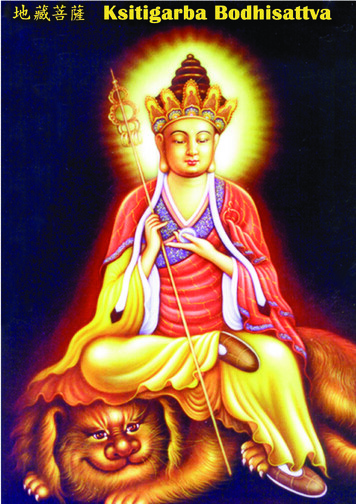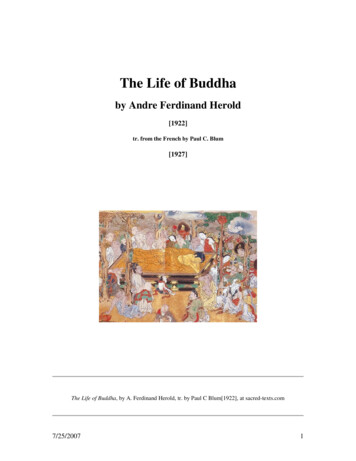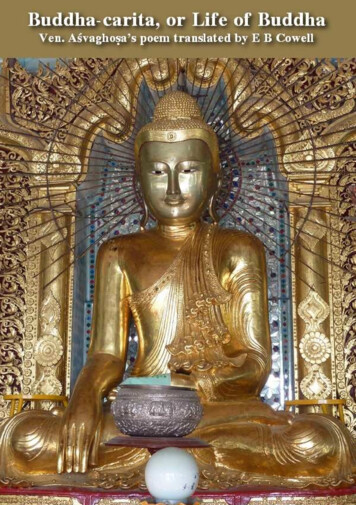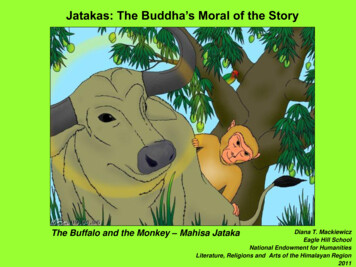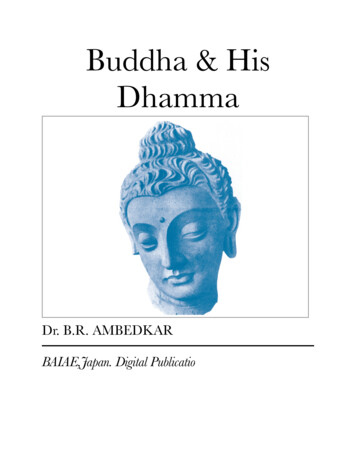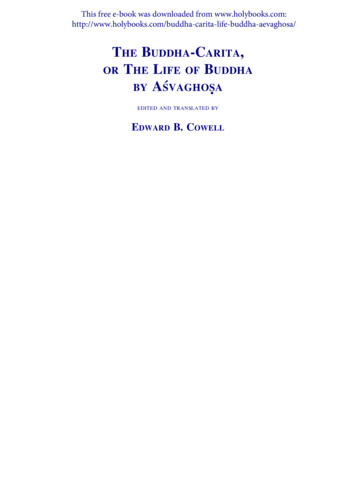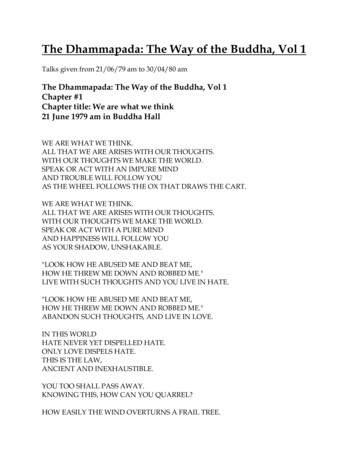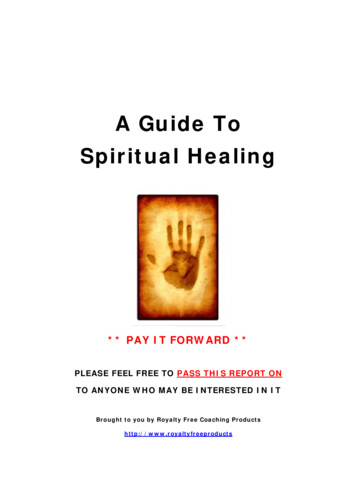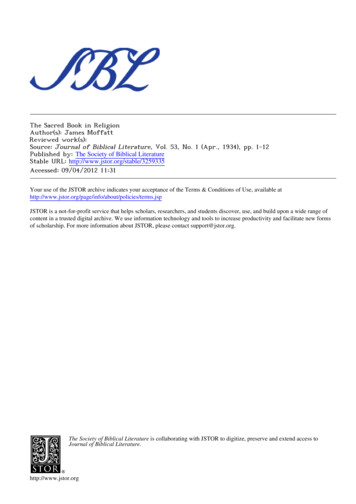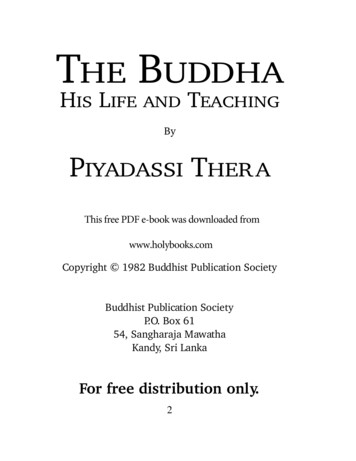
Transcription
The BuddhaHis Life and TeachingByPiyadassi TheraThis free PDF e-book was downloaded fromwww.holybooks.comCopyright 1982 Buddhist Publication SocietyBuddhist Publication SocietyP.O. Box 6154, Sangharaja MawathaKandy, Sri LankaFor free distribution only.2
You may print copies of this work for yourpersonal use.You may re-format and redistribute thiswork for use on computers and computernetworks, provided that youcharge no fees for its distribution or use.Otherwise, all rights reserved.This edition was transcribed from the printedition in 1995 by Bradford Griffith under theauspices of the DharmaNet Dharma BookTranscription Project, with the kind permissionof the Buddhist Publication Society3
Namo tassa bhagavatoarahato sammàsambuddhassa!4
The BuddhaIntroduction“The ages roll by and the Buddha seems not so faraway after all; his voice whispers in our ears andtells us not to run away from the struggle but, calmeyed, to face it, and to see in life ever greater opportunities for growth and advancement. Personalitycounts today as ever, and a person who has impressed himself on the thought of mankind as theBuddha has, so that even today there is somethingliving and vibrant about the thought of him, musthave been a wonderful man—a man who was, asBarth says, ‘the finished model of calm and sweetmajesty, of infinite tenderness for all that breathesand compassion for all that suffers, of perfect moral1freedom and exemption from every prejudice.’ ”“His message old and yet very new and original forthose immersed in metaphysical subtleties, capturedthe imagination of the intellectuals; it went deep2down into the hearts of the people.”Buddhism had its birth at Sarnath near the cityof Vàrànasi (Benares), India. With only five followers at the beginning, it penetrated into many lands,5
and is today the religion of more than 600 million.Buddhism made such rapid strides chief ly due to itsintrinsic worth and its appeal to the reasoning mind.But there were other factors that aided its progress:never did the dhammadåtas, the messengers of theDhamma, the teaching, use any iniquitous methodsin spreading the Dhamma. The only weapon theywielded was that of universal love and compassion.Furthermore, Buddhism penetrated to thesecountries peaceably, without disturbing the creedsthat were already there. Buddhist missions, to whichthe annals of religious history scarcely afford a parallel, were carried on neither by force of arms nor bythe use of any coercive or reprehensible methods.Conversion by compulsion was unknown among theBuddhists, and repugnant to the Buddha and hisdisciples. No decrying of other creeds has ever existed in Buddhism. Buddhism was thus able to diffuseitself through a great variety of cultures throughoutthe civilized world.“There is no record known to me,” wrote T.W.Rhys Davids, “in the whole of the long history ofBuddhism throughout the many centuries where itsfollowers have been for such lengthened periodssupreme, of any persecution by the Buddhists of thefollowers of any other faith.”6
The BirthThe Buddha, the founder of Buddhism, lived over2,500 years ago and is known as Siddhattha34Gotama. His father, Suddhodana, the kshatriyaking, ruled over the land of the Sàkyans at Kapilavatthu on the Nepalese frontier. As he came fromthe Gotama family, he was known as SuddhodanaGotama. Mahàmàyà, princess of the Koliyas, wasSuddhodana’s queen.In 623 B.C. on a full-moon day of May—Vasanta-tide, when in India the trees were ladenwith leaf, f lower, and fruit, and man, bird, and beastwere in joyous mood—Queen Mahàmàyà was travelling in state from Kapilavatthu to Devadaha, herparental home, according to the custom of the times,to give birth to her child. But that was not to be, forhalfway between the two cities, in the beautifulLumbini Grove, under the shade of a f lowering Saltree, she brought forth a son.Lumbini, or Rummindei, the name by which itis now known, is one hundred miles north of Vàrànasi and within sight of the snowcapped Himalayas.At this memorable spot where Prince Siddhattha, thefuture Buddha, was born, Emperor Asoka, 316 yearsafter the event, erected a mighty stone pillar to mark7
the holy spot. The inscription engraved on the pillarin five lines consists of ninety-three Asokan characters, among which occurs the following: “hida budhejàte sàkyamuni. Here was born the Buddha, the sageof the Sàkyans.”The mighty column is still to be seen. The pillar,as crisp as the day it was cut, had been struck bylightning even when Hiuen Tsiang, the Chinesepilgrim, saw it towards the middle of the seventhcentury A.C. The discovery and identification ofLumbini Park in 1896 is attributed to the renownedarchaeologist, General Cunningham.On the fifth day after the birth of the prince,the king summoned eight wise men to choose aname for the child and to speak of the royal babe’sfuture. He was named Siddhàrtha, which means onewhose purpose has been achieved. The brahminsdeliberated and seven of them held up two fingerseach and declared: “O King, this prince will becomea cakravarti, a universal monarch, should he deign torule, but should he renounce the world, he willbecome a sammà-sambuddha, a Supremely Enlightened One, and deliver humanity from ignorance.”But Koõóa a, the wisest and the youngest, afterwatching the prince, held up only one finger andsaid: “O King, this prince will one day go in search of8
truth and become a Supremely EnlightenedBuddha.”Queen Mahàmàyà, the mother, passed away onthe seventh day after the birth of her child, and thebabe was nursed by his mother’s sister, PajàpatiGotami. Though the child was nurtured tillmanhood in refinement amid an abundance ofmaterial luxury, the father did not fail to give his sonthe education that a prince ought to receive. Hebecame skilled in many branches of knowledge, andin the arts of war easily excelled all others.Nevertheless, from his childhood the prince wasgiven to serious contemplation.The Four Significant VisionsWhen the prince grew up, the father’s fervent wishwas that his son should marry, bring up a family, andbe his worthy successor; for he often recalled tomind with dread the prediction of the sage Konda a, and feared that the prince would one daygive up home for the homeless life of an ascetic.According to the custom of the time, at the early age9
of sixteen the prince was married to his cousin, thebeautiful Princess Yasodharà, the only daughter ofKing Suppabuddha and Queen Pamità of the Koliyas.The princess was of the same age as the prince.His father provided him with the greatest comforts. He had, so the story tells, three palaces, onefor each of the Indian year’s three seasons. Lackingnothing of the earthly joys of life, he lived amid songand dance, in luxury and pleasure, knowing nothingof sorrow. Yet all the efforts of the father to hold hisson a prisoner to the senses and make him worldlyminded were of no avail. King Suddhodana’s endeavours to keep away life’s miseries from his son’sinquiring eyes only heightened Prince Siddhàrtha’scuriosity and his resolute search for truth andEnlightenment. With the advance of age and maturity, the prince began to glimpse the woes of theworld.On one occasion, when the prince went drivingwith his charioteer Channa to the royal gardens, hesaw to his amazement what his eyes had neverbeheld before: a man weakened with age, and in thelast stage of ageing, crying out in a mournful voice:“Help master! lift me to my feet; oh, help!5Or I shall die before I reach my house!”10
This was the first shock the prince received.The second was the sight of a man, mere skin andbones, supremely unhappy and forlorn, “smittenwith some pest. The strength is gone from ham, andloin, and neck, and all the grace and joy of manhood6f led.” On a third occasion he saw a band of lamenting kinsmen bearing on their shoulders the corpseof one beloved for cremation. These woeful signs,seen for the first time in his life, deeply moved him.From the charioteer he learned that even he, hisbeloved Princess Yasodharà, and his kith and kin—all, without exception, are subject to ageing, disease,and death.Soon after this the prince saw a recluse movingwith measured steps and down-cast eyes, calm andserene, aloof and independent. He was struck by theserene countenance of the man. He learned fromChanna that this recluse was one who had abandoned his home to live a life of purity, to seek truthand answer the riddle of life. Thoughts of renunciation f lashed through the prince’s mind and indeep contemplation he turned homeward. The heartthrob of an agonized and ailing humanity found aresponsive echo in his own heart. The more he camein contact with the world outside his palace walls,the more convinced he became that the world was11
lacking in true happiness. But before reaching thepalace he was met by a messenger with the newsthat a son had been born to Yasodharà. “A fetter isset upon me,” uttered the prince and returned to thepalace.The Great RenunciationIn the silence of that moonlit night (it was the fullmoon day of July, âsàlha) such thoughts as thesearose in him: “Youth, the prime of life, ends in oldage and man’s senses fail him at a time when theyare most needed. The hale and hearty lose theirvigour and health when disease suddenly creeps in.Finally death comes, sudden perhaps and unexpected, and puts an end to this brief span of life.Surely there must be an escape from this unsatisfactoriness, from ageing and death.”Thus the great intoxication of youth (yobbanamada), of health (àrog ya-mada), and of life (jivitamada) left him. Having seen the vanity and thedanger of the three intoxications, he was overcomeby a powerful urge to seek and win the Deathless, to12
strive for deliverance from old age, illness, misery,and death not only for himself but for all beings7(including his wife and child) that suffer. It was hisdeep compassion that led him to the quest ending inenlightenment, in Buddhahood. It was compassionthat now moved his heart towards the greatrenunciation and opened for him the doors of thegolden cage of his home life. It was compassion thatmade his determination unshakeable even by the lastparting glance at his beloved wife asleep with thebaby in her arms.Thus at the age of twenty-nine, in the f lower ofyouthful manhood, on the day his beautiful Yasodharà had given birth to his only son, Ràhula, PrinceSiddhàrtha Gotama, discarding and disdaining theenchantment of the royal life, scorning and spurningjoys that most young men yearn for, tore himselfaway, renouncing wife and child and a crown thatheld the promise of power and glory.He cut off his long locks with his sword, doffedhis royal robes, and putting on a hermit’s robe retreated into forest solitude to seek a solution tothose problems of life that had so deeply stirred hismind. He sought an answer to the riddle of life,seeking not a palliative, but a true way out ofsuffering—to perfect enlightenment and Nibbàna.13
His quest for the supreme security from bondage—Nibbàna (Nirvàna)—had begun. This was the greatrenunciation, the greatest adventure known tohumanity.First he sought guidance from two famous sages,from Alàra Kàlàma and Uddaka Ràmaputta, hopingthat they, being masters of meditation, would teachhim all they knew, leading him to the heights ofconcentrative thought. He practised concentrationand reached the highest meditative attainments possible thereby, but was not satisfied with anythingshort of Supreme Enlightenment. These teachers’range of knowledge, their ambit of mystical experience, however, was insufficient to grant him what heso earnestly sought, and he saw himself still far fromhis goal. Though both sages, in turn, asked him tostay and succeed them as the teacher of their following, the ascetic Gotama declined. Paying obeisanceto them, he left them in search of the still unknown.In his wanderings he finally reached Uruvelà,by the river Nera jarà at Gayà. He was attracted byits quiet and dense groves, and the clear waters ofthe river were soothing to his senses and stimulatingto his mind. Nearby was a village of simple folkwhere he could get his alms. Finding that this was asuitable place to continue his quest for enlighten14
ment, he decided to stay. Soon five other asceticswho admired his determined effort joined him.They were Konda a, Bhaddiya, Vappa, Mahànàma,and Assaji.Self-mortificationThere was, and still is, a belief in India among manyof her ascetics that purification and final deliverancecan be achieved by rigorous self-mortification, andthe ascetic Gotama decided to test the truth of it.And so there at Uruvelà he began a determinedstruggle to subdue his body in the hope that hismind, set free from the shackles of the body, mightbe able to soar to the heights of liberation. Mostzealous was he in these practices. He lived on leavesand roots, on a steadily reduced pittance of food; hewore rags from dust heaps; he slept among corpsesor on beds of thorns. The utter paucity of nourishment left him a physical wreck. Says the Master:“Rigorous have I been in my ascetic discipline.Rigorous have I been beyond all others. Like wasted,withered reeds became all my limbs .” In such15
words as these, in later years, having attained to fullenlightenment, did the Buddha give his disciples an8awe-inspiring description of his early penances.Struggling thus for six long years, he came todeath’s very door, but he found himself no nearer tohis goal. The utter futility of self-mortification became abundantly clear to him by his own experience. He realized that the path to the fruition of hisardent longing lay in the direction of a searchinward into his own mind. Undiscouraged, his stillactive mind searched for new paths to the aspiredfor goal. He felt, however, that with a body so utterlyweakened as his, he could not follow that path withany chance of success. Thus he abandoned selftorture and extreme fasting and took normal food.His emaciated body recovered its former healthand his exhausted vigour soon returned. Now hisfive companions left him in their disappointment,for they thought that he had given up the effort andhad resumed a life of abundance. Nevertheless, withfirm determination and complete faith in his ownpurity and strength, unaided by any teacher, accompanied by none, the Bodhisatta resolved to make hisfinal effort in complete solitude.On the forenoon of the day before his enlightenment while the Bodhisatta was seated in medit16
ation under a banyan tree, Sujàtà, the daughter of arich householder, not knowing whether the asceticwas divine or human, offered milk-rice to himsaying: “Lord, may your aspirations be crowned withsuccess!” This was his last meal prior to his enlightenment.The Final TriumphCrosslegged he sat under a tree, which later becameknown as the Bodhi Tree, the “Tree of Enlightenment” or “Tree of Wisdom,” on the bank of the riverNera jarà, at Gayà (now known as Buddhagayà),making the final effort with the inf lexible resolution: “Though only my skin, sinews, and bonesremain, and my blood and f lesh dry up and witheraway, yet will I never stir from this seat until I haveattained full enlightenment (sammà-sambodhi).” Soindefatigable in effort, so unf lagging in his devotionwas he, and so resolute to realize truth and attainfull enlightenment.Applying himself to the “mindfulness of in-andout breathing” (ànàpàna sati), the Bodhisatta entered upon and dwelt in the first meditative absorption17
(jhàna; Skt. dhyàna). By gradual stages he enteredupon and dwelt in the second, third, and fourthjhànas. Thus cleansing his mind of impurities, withthe mind thus composed, he directed it to the knowledge of recollecting past births (pubbenivàsànussati àõa). This was the first knowledge attained by himin the first watch of the night. Then the Bodhisattadirected his mind to the knowledge of the disappearing and reappearing of beings of varied forms, ingood states of experience, and in states of woe, eachfaring according to his deeds (cutåpapàta àna). Thiswas the second knowledge attained by him in themiddle watch of the night. Next he directed his mindto the knowledge of the eradication of the taints9(àsavakkhaya àna).He understood as it really is: “This is suffering(dukkha), this is the arising of suffering, this is thecessation of suffering, this is the path leading to thecessation of suffering.” He understood as it really is:“These are defilements (àsavas), this is the arising ofdefilements, this is the cessation of defilements, thisis the path leading to the cessation of defilements.”Knowing thus, seeing thus, his mind was liberated from the defilements of sense pleasures(kàmàsava), of becoming (bhavàsava), and of ignor10ance (avijjàsava). When his mind was thus liber18
ated, there came the knowledge, “liberated” and heunderstood: “Destroyed is birth, the noble life(brahmacariya) has been lived, done is what was tobe done, there is no more of this to come” (meaning, there is no more continuity of the mind andbody, no more becoming, rebirth). This was thethird knowledge attained by him in the last watch ofthe night. This is known as tevijjà (Skt. trividyà),11threefold knowledge.Thereupon he spoke these words of victory:“Seeking but not finding the house builder,I hurried through the round of manybirths:Painful is birth ever and again.O house builder, you have been seen;You shall not build the house again.Your rafters have been broken up,Your ridgepole is demolished too.My mind has now attained the unformedNibbànaAnd reached the end of every sort of12craving.”13Thus the Bodhisatta Gotama at the age ofthirty-five, on another full moon of May (vesàkha,vesak), attained Supreme Enlightenment by comprehending in all their fullness the Four Noble Truths,19
the Eternal Verities, and he became the Buddha, theGreat Healer and Consummate Master-Physicianwho can cure the ills of beings. This is the greatestunshakeable victory.The Four Noble Truths are the priceless message that the Buddha gave to suffering humanity fortheir guidance, to help them to be rid of the bondage of dukkha, and to attain the absolute happiness,that absolute reality—Nibbàna.These truths are not his creation. He only rediscovered their existence. We thus have in theBuddha one who deserves our respect and reverencenot only as a teacher but also as model of the noble,self-sacrificing, and meditative life we would do wellto follow if we wish to improve ourselves.One of the noteworthy characteristics thatdistinguishes the Buddha from all other religiousteachers is that he was a human being having noconnection whatsoever with a God or any other“supernatural” being. He was neither God nor anincarnation of God, nor a prophet, nor any mythological figure. He was a man, but an extraordinaryman (acchariya manussa), a unique being, a man parexcellence (purisuttama). All his achievements areattributed to his human effort and his human under-20
standing. Through personal experience he understood the supremacy of man.Depending on his own unremitting energy,unaided by any teacher, human or divine, he achieved the highest mental and intellectual attainments, reached the acme of purity, and was perfectin the best qualities of human nature. He was anembodiment of compassion and wisdom, which became the two guiding principles in his Dispensation(sàsana).The Buddha never claimed to be a saviour whotried to save “souls” by means of a revealed religion.Through his own perseverance and understandinghe proved that infinite potentialities are latent inman and that it must be man’s endeavour to developand unfold these possibilities. He proved by his ownexperience that deliverance and enlightenment liefully within man’s range of effort.“Religion of the highest and fullest charactercan coexist with a complete absence of belief inrevelation in any straightforward sense of the word,and in that kernel of revealed religion, a personalGod. Under the term personal God I include all ideasof a so-called superpersonal god, of the same spiritual and mental nature as a personality but on ahigher level, or indeed any supernatural spiritual21
existence or force.” (Julian Huxley, Religion WithoutRevelation, pp. 2 and 7.)Each individual should make the appropriateeffort and break the shackles that have kept him inbondage, winning freedom from the bonds ofexistence by perseverance, self-exertion, and insight.It was the Buddha who for the first time in theworld’s history taught that deliverance could beattained independently of an external agency, thatdeliverance from suffering must be wrought andfashioned by each one for himself upon the anvil ofhis own actions.None can grant deliverance to another whomerely begs for it. Others may lend us a helpinghand by guidance and instruction and in other ways,but the highest freedom is attained only throughself-realization and self-awakening to truth and notthrough prayers and petitions to a Supreme Being,human or divine. The Buddha warns his disciplesagainst shifting the burden to an external agency,directs them to the ways of discrimination andresearch, and urges them to get busy with the realtask of developing their inner forces and qualities.22
MisconceptionsThere are some who take delight in making theBuddha a non-human. They quote a passage fromthe Anguttara Nikàya (II, 37), mistranslate it, andmisunderstand it. The story goes thus:Once the Buddha was seated under a tree in themeditation posture, his senses calmed, his mindquiet, and attained to supreme control and serenity.Then a Brahmin, Dona by name, approached theBuddha and asked:“Sir, will you be a god, a deva?”“No, brahmin.”“Sir, will you be a heavenly angel, agandhabba?”“No, brahmin.”“Sir, will you be a demon, a yakkha?”“No, brahmin.”“Sir, will you be a human being, a manussa?”“No, brahmin.”“Then, sir, what indeed will you be?”Now understand the Buddha’s reply carefully:“Brahmin, whatever defilements (àsavas) therebe owing to the presence of which a person may beidentified as a god or a heavenly angel or a demonor a human being, all these defilements in me are23
abandoned, cut off at the root, made like apalm-tree stump, done away with, and are no moresubject to future arising.“Just as, brahmin, a blue or red or white lotusborn in water, grows in water and stands up abovethe water untouched by it, so too I, who was born inthe world and grew up in the world, havetranscended the world, and I live untouched by theworld. Remember me as one who is enlightened(Buddhoti mam dhàrehi bràhmana).”What the Buddha said was that he was not agod or a heavenly angel or a demon or a humanbeing full of defilements. From the above it is clearthat the Buddha wanted the brahmin to know thathe was not a human being with defilements. He didnot want the brahmin to put him into any of thosecategories. The Buddha was in the world but not ofthe world. This is clear from the simile of the lotus.Hasty critics, however, rush to a wrong conclusionand want others to believe that the Buddha was nota human being.In the Anguttara Nikàya (I, 22), there is a clearinstance in which the Buddha categorically declaredthat he was a human being:“Monks, there is one person (puggala) whosebirth into this world is for the welfare and happiness24
of many, out of compassion for the world, for thegain and welfare and happiness of gods (devas) andhumanity. Who is this one person (eka puggala)? It is theTathàgata, who is a Consummate One (arahat), aSupremely Enlightened One (sammà-sambuddho) Monks, one person born into the world is an extraordinary man, a marvellous man (acchariya manussa).”Note the Påli word manussa, a human being.Yes, the Buddha was a human being but not just another man. He was a marvellous man.The Buddhist texts say that the Bodhisatta (ashe is known before he became the Buddha) was inthe Tusita heaven (devaloka) but came down to thehuman world to be born as a human being (manussatta). His parents, King Suddhodana and QueenMahàmàyà, were human beings.The Bodhisatta was born as a man, attainedenlightenment (Buddhahood) as a man, and finallypassed away into parinibbàna as a man. Even afterhis Supreme Enlightenment he did not call himself aGod or Brahmà or any “supernatural being,” but anextraordinary man.Dr. S. Radhakrishnan, a Hindu steeped in thetenets of the Vedas and Vedanta, says that Buddhismis an offshoot of Hinduism, and even goes to theextent of calling the Buddha a Hindu. He writes:25
“The Buddha did not feel that he was announcing a new religion. He was born, grew up, and dieda Hindu. He was restating with a new emphasis the14ancient ideals of the Indo-Aryan civilization.”But the Buddha himself declares that his teaching was a revelation of truths discovered by himself,not known to his contemporaries, not inherited frompast tradition. Thus, in his very first sermon, referring to the Four Noble Truths, he says: “Monks, withthe thought ‘This is the noble truth of suffering, thisis its cause, this is its cessation, this is the wayleading to its cessation,’ there arose in me vision,knowledge, wisdom, insight, and light concerningthings unheard of before (pubbesu ananussutesu15dhammesu).”Again, while making clear to his disciples thedifference between a Fully Enlightened One and thearahats, the consummate ones, the Buddha says:“The Tathàgata, O disciples, while being an arahat isfully enlightened. It is he who proclaims a way notproclaimed before, he is the knower of a way, whounderstands a way, who is skilled in a way (magga u, maggavidu, maggakovido). And now his dis16ciples are wayfarers who follow in his footsteps.”The ancient way the Buddha refers to is theNoble Eightfold Path and not any ideals of the26
Indo-Aryan civilization as Dr. Radhakrishnanimagines.However, referring to the Buddha, MahatmaGandhi, the architect of Indian independence, says:“By his immense sacrifice, by his great renunciationand by the immaculate purity of his life, he left anindelible impress upon Hinduism, and Hinduismowes an eternal debt of gratitude to that greatteacher.” (Mahàdev Desai, With Gandhiji in Ceylon,Madras, 1928, p.26.)Dependent ArisingFor a week, immediately after the enlightenment,the Buddha sat at the foot of the Bodhi Tree, experiencing the supreme bliss of emancipation. At the endof the seven days he emerged from that concentration (samàdhi) and in the first watch of the nightthought over the dependent arising (paticcasamuppàda) as to how things arise (anuloma) thus:“When this is, that comes to be; with the arisingof this, that arises; namely: dependent on ignorance,volitional or kamma formations; dependent on volitional formations, (rebirth or rebecoming) conscious27
ness; dependent on consciousness, mentalitymateriality (mental and physical combination);dependent on mentality-materiality, the sixfold base(the five physical sense organs with consciousness asthe sixth); dependent on the sixfold base, contact;depend on contact, feeling; dependent on feeling,craving; dependent on craving, clinging; dependenton clinging, the process of becoming; dependent onthe process of becoming, there comes to be birth;dependent on birth arise ageing and death, sorrow,lamentation, pain, grief, and despair. Thus does thiswhole mass of suffering arise.”In the second watch of the night, the Buddhathought over the dependent arising as to how thingscease (patiloma) thus: “When this is not, that doesnot come to be; with the cessation of this, thatceases; namely: with the utter cessation of ignorance, the cessation of volitional formations; with thecessation of formations, the cessation of consciousness (and so on). Thus does this whole mass ofsuffering cease.”In the third watch of the night, the Buddhathought over the dependent arising both as to howthings arise and cease thus:“When this is, that comes to be; with the arisingof this, that arises; when this is not, that does not28
come to be; with the cessation of this, that ceases;namely: dependent on ignorance, volitional formations (and so on). Thus does this whole mass ofsuffering arise. With the utter cessation of ignorance,the cessation of volitional formations (and so on).17Thus does this whole mass of suffering cease.”The Buddha now spent six more weeks in lonelyretreat at six different spots in the vicinity of theBodhi Tree. At the end of this period two merchants,Tapassu and Bhallika, who were passing that way,offered rice cake and honey to the Master, and said:“We go for refuge to the Buddha and to the18Dhamma. Let the Blessed One receive us as his19followers.” They became his first lay followers(upàsakas).The First SermonNow while the Blessed One dwelt in solitude thisthought occurred to him: “The Dhamma I haverealized is deep, hard to see, hard to understand,peaceful and sublime, beyond mere reasoning,subtle, and intelligible to the wise. But this generation delights, revels, and rejoices in sensual pleas29
ures. It is hard for such a generation to see thisconditionality, this dependent arising. Hard too is itto see this calming of all conditioned things, thegiving up of all substance of becoming, the extinction of craving, dispassion, cessation, Nibbàna. Andif I were to teach the Dhamma and others were notto understand me, that would be a weariness, a vex20ation for me.”Pondering thus he was first reluctant to teachthe Dhamma, but on surveying the world with hismental eye, he saw beings with little dust in theireyes and with much dust in their eyes, with keenfaculties and dull faculties, with good qualities andbad qualities, easy to teach and hard to teach, somewho are alive to the perils hereafter of presentwrongdoings, and some who are not. The Masterthen declared his readiness to proclaim the Dhammain this solemn utterance:“Apàrutà tesam amatassa dvàràYe sotavanto pamu cantu saddham.”“Open are the doors of the Deathless.Let those that have ears repose trust.”When considering to whom he should teach theDhamma first
This free PDF e-book was downloaded from www.holybooks.com. 3 You may print copies of this work for your personal use. You may re-format and redistribute this . of the Buddhist Publication Society. 4 Namo tassa bhagavato arahato sammà sambuddhassa! 5 The Buddha Introduction


